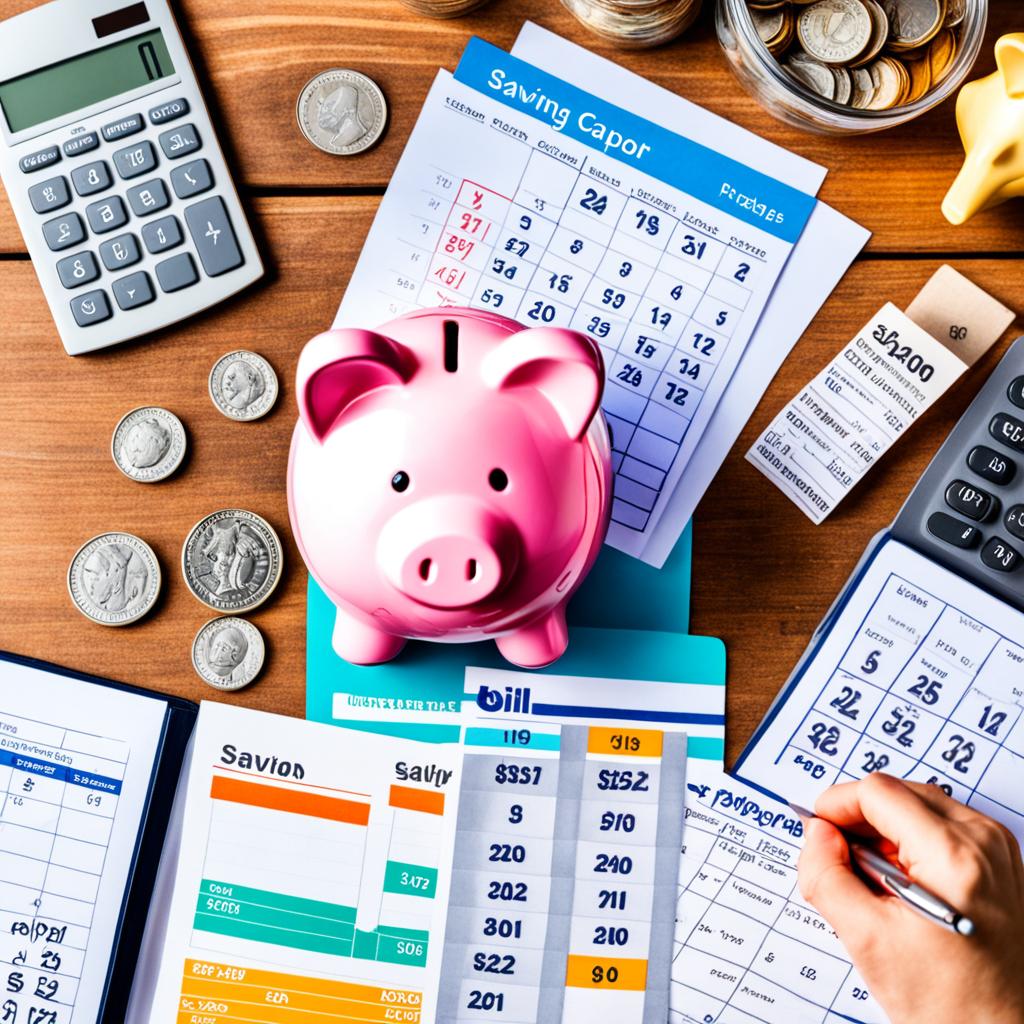Saving money is an essential skill that can lead to financial security and freedom. In this article, I will share effective strategies and tips on how to save money. These strategies include understanding your finances, implementing budgeting techniques, reducing everyday expenses, adopting smart financial habits, making extra money, and utilizing savings tools. By following these strategies, you can save money and achieve your financial goals.
When it comes to saving money, it’s all about being smart with your finances and finding ways to cut expenses. By adopting frugal living ideas and effective budgeting techniques, you can make your money work harder for you. Financial planning advice and smart money management strategies will help you build a strong foundation for your future.
Key Takeaways:
- Understanding your finances is the first step towards saving money.
- Implement effective budgeting strategies by creating a monthly budget and identifying areas to cut costs.
- Reduce everyday expenses by saving on groceries, cutting utility costs, and lowering transportation expenses.
- Develop smart financial habits such as building an emergency fund and prioritizing debt repayment.
- Explore opportunities to make extra money through side hustles, freelance work, or passive income.
Understanding Your Finances
Before you can start saving money, it’s important to understand your finances. This involves assessing your income and expenses to get a clear picture of where your money is going. By assessing your finances, you can identify areas where adjustments can be made to cut back on spending and save more effectively.
To get started, gather all your financial documents, such as bank statements, pay stubs, and bills. This will give you a comprehensive overview of your income and expenses. Take the time to categorize your expenses into different categories, such as housing, transportation, groceries, and entertainment. This will help you see where your money is being allocated and where you may have opportunities to make adjustments.
Once you have a clear understanding of your income and expenses, it’s important to set realistic financial goals. These goals will serve as your motivation to save and provide a clear target to work towards. Whether you’re saving for a down payment on a house, planning for retirement, or building an emergency fund, setting specific goals will help you stay focused and disciplined in your savings journey.
Remember, understanding your finances is the first step towards effective money management. By assessing your income and expenses and setting financial goals, you’ll be better equipped to make informed decisions about your spending and saving habits.
Assessing Income and Expenses
When assessing your income and expenses, it’s essential to have a comprehensive understanding of your financial situation. This includes:
- Evaluating your sources of income: Calculate your total monthly income from various sources, such as your salary, freelance work, investments, or rental income.
- Analyzing your fixed expenses: Identify your fixed monthly expenses, such as rent/mortgage, utilities, insurance, and loan payments. These expenses generally remain consistent each month.
- Examining your variable expenses: Consider your discretionary expenses, including groceries, dining out, entertainment, and shopping. These expenses can vary month to month and offer opportunities for cost-cutting.
- Reviewing your debt obligations: Take stock of any outstanding debts, such as student loans or credit card balances. It’s important to factor in monthly debt payments when assessing your overall financial situation.
By evaluating your income and expenses with a critical eye, you’ll gain a better understanding of your financial health and be able to identify areas where you can make adjustments.
Setting Financial Goals
Setting financial goals is a crucial part of managing your money effectively. Consider the following steps when setting your financial goals:
- Identify your short-term and long-term goals: Short-term goals may include saving for a vacation or paying off a credit card, while long-term goals might involve buying a home or planning for retirement.
- Make your goals specific and measurable: Rather than setting a general goal like “save more money,” make it more tangible and measurable, such as “save $500 per month.”
- Set realistic targets: Ensure that your goals are achievable based on your current financial situation. Setting unrealistic goals can lead to frustration and discouragement.
- Break down your goals: Divide larger goals into smaller, more manageable milestones. This can help you stay motivated and track your progress along the way.
Once you’ve set your financial goals, write them down and place them somewhere visible as a daily reminder of what you’re working towards. Regularly review and reassess your goals as your financial situation evolves.
Understanding your finances and setting clear financial goals are essential steps on your journey to saving money. By assessing your income and expenses and identifying areas for adjustment, you can make informed decisions about your spending and saving habits. Remember, financial awareness is the foundation for achieving your desired financial future.
Effective Budgeting Strategies
Creating a budget is an essential step towards successful money-saving. By creating a monthly budget, you can gain a clear overview of your income and expenses, allowing you to make informed financial decisions. Here are some effective budgeting strategies to help you get started:
1. Outline Your Income and Expenses
Begin by outlining your monthly income sources, such as your salary or any additional sources of income. Then, categorize your expenses into essential and non-essential categories. Essential expenses include rent or mortgage payments, utility bills, groceries, and transportation costs. Non-essential expenses include entertainment, dining out, and personal shopping.
2. Allocate Your Income
Once you have a clear understanding of your income and expenses, allocate your income towards essential expenses first. This ensures that your basic needs are covered. Set aside a portion of your income for savings to build an emergency fund or work towards your financial goals. Prioritizing your savings will help you achieve long-term financial stability.
3. Identify Areas to Cut Costs
Take a closer look at your non-essential expenses and identify areas where you can cut costs. For example, you can reduce dining out expenses by cooking at home more often or finding affordable alternatives. Consider eliminating unnecessary subscriptions or memberships that you no longer use. These small adjustments can yield significant savings over time.
4. Utilize Budgeting Tools and Apps
Take advantage of budgeting tools and apps that can help you track your spending and stay on top of your budget. Some popular options include Mint, YNAB (You Need a Budget), and Personal Capital. These tools allow you to categorize your expenses, set financial goals, and receive personalized insights into your spending habits.
By following these effective budgeting strategies, you can take control of your finances and make informed decisions to maximize your savings. Creating a budget not only helps you identify areas where you can cut costs but also provides a roadmap for achieving your financial goals.
| Budgeting Strategies | Benefits |
|---|---|
| Creating a monthly budget | – Allows you to track income and expenses – Provides a clear overview of your financial situation – Helps you prioritize savings |
| Allocating income towards essential expenses and savings | – Ensures basic needs are covered – Builds a financial safety net – Helps achieve long-term financial goals |
| Identifying areas to cut costs | – Frees up funds for savings – Reduces unnecessary expenses – Increases financial efficiency |
| Utilizing budgeting tools and apps | – Makes tracking expenses easier – Provides insights into spending habits – Encourages financial accountability |
Implementing these budgeting strategies will empower you to make the most of your financial resources. By creating a budget, allocating your income wisely, identifying areas to cut costs, and leveraging budgeting tools and apps, you can take control of your finances and work towards a more secure financial future.
Reducing Everyday Expenses
To save money, it’s important to reduce your everyday expenses. By making small changes and adopting smart financial habits, you can achieve significant savings over time. Here are some effective strategies to help you lower your expenses and put more money back in your pocket.
Save on Groceries
Groceries can be a major expense, but with some planning and smart shopping techniques, you can save a significant amount of money. Consider the following:
- Plan your shopping trips: Make a list of the items you need and stick to it to avoid impulse buying.
- Use coupons and loyalty programs: Take advantage of discounts and rewards offered by your favorite stores.
Table: Example Grocery Savings
| Expenses | Monthly | Annual |
|---|---|---|
| Groceries before savings | $500 | $6,000 |
| Groceries after savings | $400 | $4,800 |
| Savings | $100 | $1,200 |
Cut Utility Costs
Reducing your utility costs not only helps you save money but also benefits the environment. Try these tips to minimize your energy usage:
- Be mindful of energy usage: Turn off lights and unplug electronics when not in use.
- Consider energy-efficient appliances: Upgrading to energy-efficient appliances can result in long-term savings.
Lower Transportation Expenses
Transportation costs can quickly accumulate, but there are ways to lower your expenses:
- Use public transit: Consider taking public transportation instead of driving, especially for your daily commute.
- Carpool or bike: Share rides with coworkers or friends, or use a bike for short distances.
These small changes can make a big difference in your overall expenses. By reducing your everyday costs, you’ll have more money to put towards your savings goals and achieve financial freedom.
Smart Financial Habits
Developing smart financial habits is crucial for long-term savings success. By incorporating these habits into your daily life, you can build a strong financial foundation, achieve your goals, and secure your future. Here are some key financial habits to consider:
Building an Emergency Fund
One of the first smart financial habits you should adopt is building an emergency fund. Life is full of unexpected expenses, such as medical bills or car repairs, and having a financial cushion can help you weather these storms without derailing your savings progress. Aim to save three to six months’ worth of living expenses in your emergency fund to provide yourself with a safety net.
Prioritizing Debt Repayment
Paying off debt should be a priority when it comes to your financial goals. High-interest debt, such as credit card debt, can accumulate quickly and hinder your ability to save. Develop a debt repayment plan by prioritizing debts with the highest interest rates, making extra payments whenever possible, and avoiding new debt. By tackling your debts head-on, you’ll not only save money on interest payments but also free up more funds to put towards your savings goals.
Automating Your Savings
Automating your savings is a smart way to ensure consistent progress towards your financial goals. Set up an automatic transfer from your checking account to your savings account on a recurring basis, whether it’s monthly or with each paycheck. This habit eliminates the temptation to spend money that could otherwise be saved and allows your savings to grow effortlessly over time.
Practicing Mindful Spending
Mindful spending involves being conscious of your financial decisions and prioritizing your needs over wants. Before making a purchase, ask yourself if it aligns with your financial goals and if it’s truly necessary. By curbing impulsive spending and avoiding unnecessary purchases, you can save money that could be better utilized towards achieving your long-term financial objectives.
Remember, it’s not about depriving yourself of everything you enjoy, but finding a balance between your present desires and your long-term financial security.
Practice Makes Perfect
Building smart financial habits takes time and practice. It’s okay to start small and gradually incorporate these habits into your daily routine. Over time, they will become second nature, and you’ll see the positive impact they have on your financial well-being. Stay consistent, remain focused on your goals, and celebrate your progress along the way.
Making Extra Money
If you’re looking to boost your savings, I have some great suggestions for making extra money. These side hustles and freelance opportunities can help you generate additional income while still enjoying the flexibility and freedom that comes with it.
Explore Side Hustles
Side hustles are a fantastic way to make extra money outside of your regular job. They allow you to leverage your skills and interests to earn additional income. Whether you’re a talented photographer, a skilled writer, or a tech-savvy individual, there are numerous side hustles that you can explore to monetize your expertise.
“A side hustle can be anything from freelancing on platforms like Upwork or Fiverr to starting a small business of your own. The key is to find something that you enjoy and that aligns with your skills.”
Freelance Work
If you’re looking for more flexibility and independence, freelance work might be the perfect option for you. Freelancing allows you to work on a project basis, giving you the freedom to choose when and where you work. There are various freelance opportunities available across different industries, such as writing, graphic design, coding, and digital marketing. By offering your services as a freelancer, you can monetize your skills and earn extra income.
Earn Passive Income
Passive income is an excellent way to make money without actively trading your time for it. It involves earning income from assets or investments that require minimal effort on your part once they’re set up. Some popular passive income streams include rental properties, investing in dividend-paying stocks, creating and selling online courses, or generating revenue through affiliate marketing.
“Passive income can provide you with a steady stream of money even when you’re not actively working. It’s like earning money while you sleep!”
To kick-start your passive income journey, consider renting out a spare room in your house through platforms like Airbnb. You can also explore starting an online business that generates income through digital products, dropshipping, or print-on-demand services. With dedication and strategic planning, you can create multiple passive income streams that contribute to your savings goals.
| Side Hustles | Freelance Work | Passive Income |
|---|---|---|
| – Photography | – Writing | – Rental properties |
| – Graphic design | – Graphic design | – Dividend-paying stocks |
| – Online tutoring | – Coding | – Online courses |
Utilizing Savings Tools
When it comes to saving money, utilizing savings tools can make a significant difference. These tools can help you maximize your savings, track your expenses, and grow your wealth over time. Here are some key savings tools to consider:
1. High-Yield Savings Accounts
A high-yield savings account is a powerful tool for growing your savings. These accounts offer higher interest rates compared to traditional savings accounts, allowing your money to work harder for you. By earning more interest, your savings can grow faster, helping you reach your financial goals sooner.
2. Investment Accounts
Investment accounts, such as Individual Retirement Accounts (IRAs) or 401(k)s, provide opportunities for long-term wealth accumulation. By investing in stocks, bonds, or mutual funds, you can potentially earn higher returns on your money. However, it’s important to assess your risk tolerance and seek professional advice before diving into the world of investments.
3. Budgeting Apps
Keeping track of your expenses is crucial for effective saving. Budgeting apps can help you stay organized and monitor your spending habits. They provide insights into your financial patterns, highlight areas where you can cut back, and even send notifications to remind you of upcoming bills. Popular budgeting apps include Mint, YNAB (You Need a Budget), and Personal Capital.

| Savings Tool | Description | Key Benefits |
|---|---|---|
| High-Yield Savings Accounts | A savings account with higher interest rates |
|
| Investment Accounts | Accounts for long-term wealth accumulation through investments |
|
| Budgeting Apps | Mobile or web applications for tracking expenses and managing budgets |
|
These savings tools can help you make the most of your money, ensuring that you’re on the right track towards achieving your financial goals.
Automate Transfers
An effective way to save money is to automate transfers from your checking account to your savings account. By setting up automatic transfers, you can effortlessly and consistently build your savings over time. There are various methods to automate transfers:
1. Manual Transfers
You can manually transfer a fixed amount from your checking account to your savings account on a regular basis. Simply log in to your online banking platform or visit your bank’s branch to set up this recurring transfer. Choose a frequency that aligns with your financial goals, such as weekly or monthly transfers. This method allows you to have complete control over your transfers.
2. Digit
Digit is an app that uses artificial intelligence to analyze your spending habits and automatically transfers small amounts of money from your checking account to your savings account. It evaluates your income and expenses to determine how much you can save without affecting your daily life. Digit aims to make saving easy and painless by saving money in small increments.
3. Qapital
Qapital is another app that helps you save money automatically. With Qapital, you can set personalized savings goals and create rules to trigger automatic transfers based on your spending habits. For example, you can set a rule to save a certain percentage of every purchase you make. Qapital provides a gamified experience to encourage consistent savings.
Automating transfers not only saves you time and effort but also eliminates the temptation to spend money earmarked for savings. It allows you to prioritize your financial goals and consistently contribute to your savings without even thinking about it.
| Method | Description |
|---|---|
| Manual Transfers | A fixed amount is manually transferred from checking to savings on a regular basis. |
| Digit | An app that analyzes spending habits and automatically transfers small amounts to savings. |
| Qapital | An app that helps set personal savings goals and triggers automatic transfers based on spending rules. |
Count Your Coins and Bills
Another effective method of saving money is by counting your coins and bills and setting them aside each day. It may seem like small change, but over time, it can make a significant impact on your savings. By collecting this physical money and depositing it into your savings account, you’re taking a proactive approach to saving.
Counting your coins and bills manually allows you to see the progress you’re making. It’s a tangible reminder of your efforts and can be quite satisfying to watch your savings grow. Plus, physically handling your money can make you more aware of your spending habits and help cultivate a mindful approach to your finances.
If you typically use credit cards for your everyday expenses, consider using cash instead. Using cash can make you more conscious of how much you’re spending and encourage you to think twice before making impulse purchases. It adds an extra layer of mindfulness to your spending habits.
So start counting your coins and bills, and remember – every penny counts!
Prep for Grocery Shopping
When it comes to saving money on groceries, a little preparation can go a long way. By following these grocery shopping tips, you can maximize your savings and reduce your expenses.
Make a Meal Plan
One of the most effective ways to save money on groceries is to make a meal plan. Take some time each week to plan out your meals, including breakfast, lunch, dinner, and snacks. By knowing exactly what you need, you can avoid buying unnecessary items and reduce food waste.
Create a Shopping List
Before heading to the grocery store, create a shopping list based on your meal plan. Stick to this list while you shop to avoid impulse buying and stay focused on the items you actually need. This simple strategy can help you stay on budget and prevent overspending.
Look for Coupons
Coupons are a great way to save money at the grocery store. Keep an eye out for coupons in newspapers, magazines, or online. Many grocery stores also offer digital coupons that you can load onto your store loyalty card. Take advantage of these discounts to save even more on your groceries.
Take Advantage of Loyalty Programs
Many grocery stores offer loyalty programs that allow you to earn points or discounts on your purchases. Sign up for these programs and take advantage of any perks or special offers they provide. By being a loyal customer, you can enjoy extra savings on your grocery shopping.
Utilize Cash-Back Credit Cards
If you’re looking for additional savings, consider using a cash-back credit card for your grocery shopping. Look for credit cards that offer cash back on groceries and use them for your purchases. Be sure to pay off your balance in full each month to avoid interest charges.
By preplanning your grocery shopping trips, making a meal plan, creating a shopping list, looking for coupons, utilizing loyalty programs, and using cash-back credit cards, you can save money on your groceries and stick to your budget. Start implementing these tips today and watch as your savings grow!
| Grocery Shopping Tips | Key Benefits |
|---|---|
| Make a meal plan | – Reduces food waste |
| Create a shopping list | – Avoids impulse buying |
| Look for coupons | – Discounts on groceries |
| Utilize loyalty programs | – Earns points or discounts |
| Use cash-back credit cards | – Earns cash back on purchases |
Minimize Restaurant Spending
Eating out at restaurants can quickly become a major expense. To save money and better manage your budget, consider reducing your restaurant spending and opting to cook at home more often. By making mindful choices when it comes to dining out, you can still enjoy delicious meals while keeping your expenses under control.
One effective way to reduce restaurant spending is by meal prepping and planning your meals in advance. This allows you to have pre-prepared meals readily available, making it less tempting to order takeout or dine out. Not only does meal prepping save you money, but it also saves you time and ensures that you have nutritious meals on hand.
When you do choose to eat out, it’s important to be conscious of the costs. Look for affordable dining options like budget-friendly restaurants or establishments that offer daily specials. Sharing meals with others is another great strategy to reduce costs while still enjoying a dining experience outside of your home.
Remember, dining out should be a treat rather than a daily occurrence. Save restaurant visits for special occasions or when you truly want to enjoy a unique culinary experience. By prioritizing cooking at home and being selective about when you dine out, you can significantly reduce your restaurant spending and allocate those funds towards your financial goals.

Dining Out Tips:
- Meal prep and plan your meals in advance to avoid the temptation of eating out.
- Look for affordable dining options and budget-friendly restaurants.
- Share meals with others to reduce costs.
- Save restaurant visits for special occasions or unique culinary experiences.
By adopting these dining out tips and consistently reducing your restaurant spending, you can make a significant impact on your overall expenses and improve your financial well-being.
Monitor Your Spending
To effectively save money, it’s important to monitor your spending regularly. Keeping track of your expenses allows you to stay within your budget and make informed financial decisions. Thankfully, there are financial apps and budget tracking tools available to help simplify this process.
By using these tools, you can easily track your income and expenses, categorize your spending, and set budget goals. They provide a clear overview of where your money is going and allow you to identify areas where you may be overspending.
One popular financial app that can assist you in monitoring your spending is Mint. It provides a comprehensive view of your finances, tracks your expenses, and sends alerts when you’re approaching your budgeted limits. With Mint, you can easily stay on top of your spending habits and make adjustments as needed.
Additionally, regularly reviewing your bank and credit card statements is essential to ensure accuracy and catch any discrepancies or unauthorized charges. This allows you to address any issues promptly and avoid unnecessary expenses.
Monitoring your spending not only helps you stay within your budget but also provides valuable insights into your financial habits. It allows you to make more informed decisions, identify areas for improvement, and ultimately achieve your savings goals.
Create a Budget Tracking Table
To better monitor your spending, consider creating a budget tracking table where you can record your income, expenses, and savings goals. This table will provide a visual representation of your financial situation and help you stay accountable.
| Category | Estimated Amount | Actual Amount | Difference |
|---|---|---|---|
| Income | $[amount] | $[amount] | $[difference] |
| Housing | $[amount] | $[amount] | $[difference] |
| Transportation | $[amount] | $[amount] | $[difference] |
| Groceries | $[amount] | $[amount] | $[difference] |
| Entertainment | $[amount] | $[amount] | $[difference] |
| Savings | $[amount] | $[amount] | $[difference] |
Use the table to track your expenses on a monthly basis and compare them to your estimated amounts. The difference column will help you identify areas where you may need to adjust your spending.
Remember, monitoring your spending and staying within your budget are key to achieving your financial goals and building a secure financial future.
Revise Your Emergency Fund
Your emergency fund is a crucial component of your financial resilience. Regularly reviewing and revising your emergency fund will ensure it aligns with your current needs and expenses. By having a well-funded emergency fund, you can navigate unexpected financial challenges without resorting to debt or jeopardizing your savings.
When revising your emergency fund, consider the following:
- Evaluate your current needs and expenses: Take stock of your monthly bills, living expenses, and any potential financial obligations that may arise.
- Assess the adequacy of your existing emergency fund: Determine if your current savings would cover at least three to six months’ worth of living expenses, or if adjustments are necessary.
- Set realistic savings goals: Determine how much you need to save to reach your desired emergency fund balance, taking into account your income and expenses.
- Automate your savings: Consider setting up automatic transfers from your checking account to your emergency fund to ensure consistent contributions and make saving easier.
- Revisit your financial priorities: If you have other financial goals, such as paying off debt or saving for a specific purpose, balance your contributions to your emergency fund with these priorities.
Having a well-funded emergency fund provides a sense of security and peace of mind, knowing that unexpected expenses can be managed without jeopardizing your financial stability. Take the necessary steps to revise and build your emergency fund, and you’ll be better prepared to handle any financial surprises that come your way.
Conclusion
Saving money is an essential skill that requires discipline and sacrifice. By implementing effective strategies and adopting smart financial habits, you can successfully save money and achieve your financial goals. Understanding your finances is the first step towards financial security. Assess your income and expenses, set clear financial goals, and create a budget to allocate your money wisely.
Reducing everyday expenses is crucial for long-term savings success. Look for ways to save on groceries, cut utility costs, and lower transportation expenses. Develop smart financial habits such as building an emergency fund and prioritizing debt repayment. Consider making extra money through side hustles or freelance work to boost your savings.
Utilize savings tools like high-yield savings accounts and investment accounts to grow your savings over time. Automate transfers and count your coins and bills to make saving money effortless. Plan your grocery shopping trips and minimize restaurant spending. Monitor your spending regularly and revise your emergency fund to stay financially resilient.
With dedication and perseverance, you can build a strong financial foundation and secure your future. Take control of your finances today and start saving money to achieve your goals. Remember, it’s the small changes and consistent effort that add up to significant savings. Stay focused, stay committed, and watch your savings grow.
FAQ
How do I understand my finances?
What are effective budgeting strategies?
How can I reduce everyday expenses?
What are some smart financial habits I should adopt?
How can I make extra money?
What savings tools can I utilize?
How can I automate transfers to save money?
What can I do with my change and small bills?
How can I save money on groceries?
How can I minimize restaurant spending?
How should I monitor my spending?
How often should I revise my emergency fund?
Source Links
- https://www.mcbt.com/The 5 Most Effective Strategies To Save Money For The Future
- https://www.businessinsider.com/personal-finance/how-to-save-money
- https://www.nerdwallet.com/article/finance/how-to-save-money
Money posts:
 Investing Your Emergency Fund
Investing Your Emergency Fund
 Money to Move Out: How Much Do You Really Need? (2024)
Money to Move Out: How Much Do You Really Need? (2024)
 What is a Checking Account Buffer? (2024)
What is a Checking Account Buffer? (2024)
 Best Money Tools 2: Managing Your Finances Made Easy (2024)
Best Money Tools 2: Managing Your Finances Made Easy (2024)
 50 Things I’ve Learned About Money
50 Things I’ve Learned About Money
 20 Ways Teens Can Prepare for Financial Independence (2024)
20 Ways Teens Can Prepare for Financial Independence (2024)
 How to Spend Less Money: A Comprehensive Guide
How to Spend Less Money: A Comprehensive Guide
 Simplifi vs Mint: What’s the Difference? (2024)
Simplifi vs Mint: What’s the Difference? (2024)

